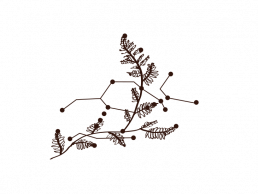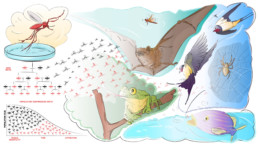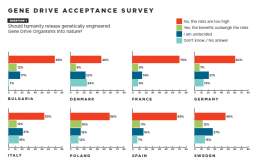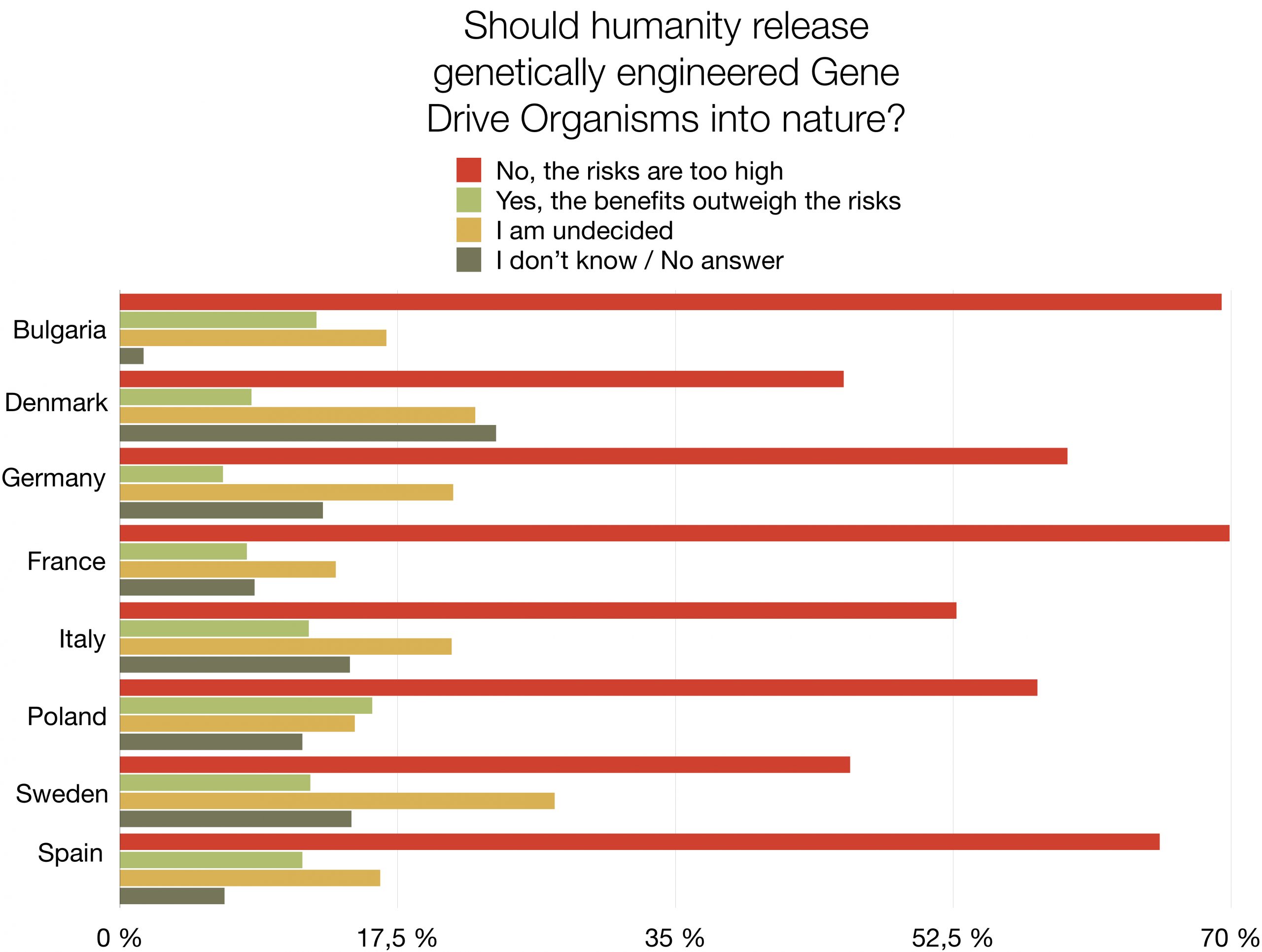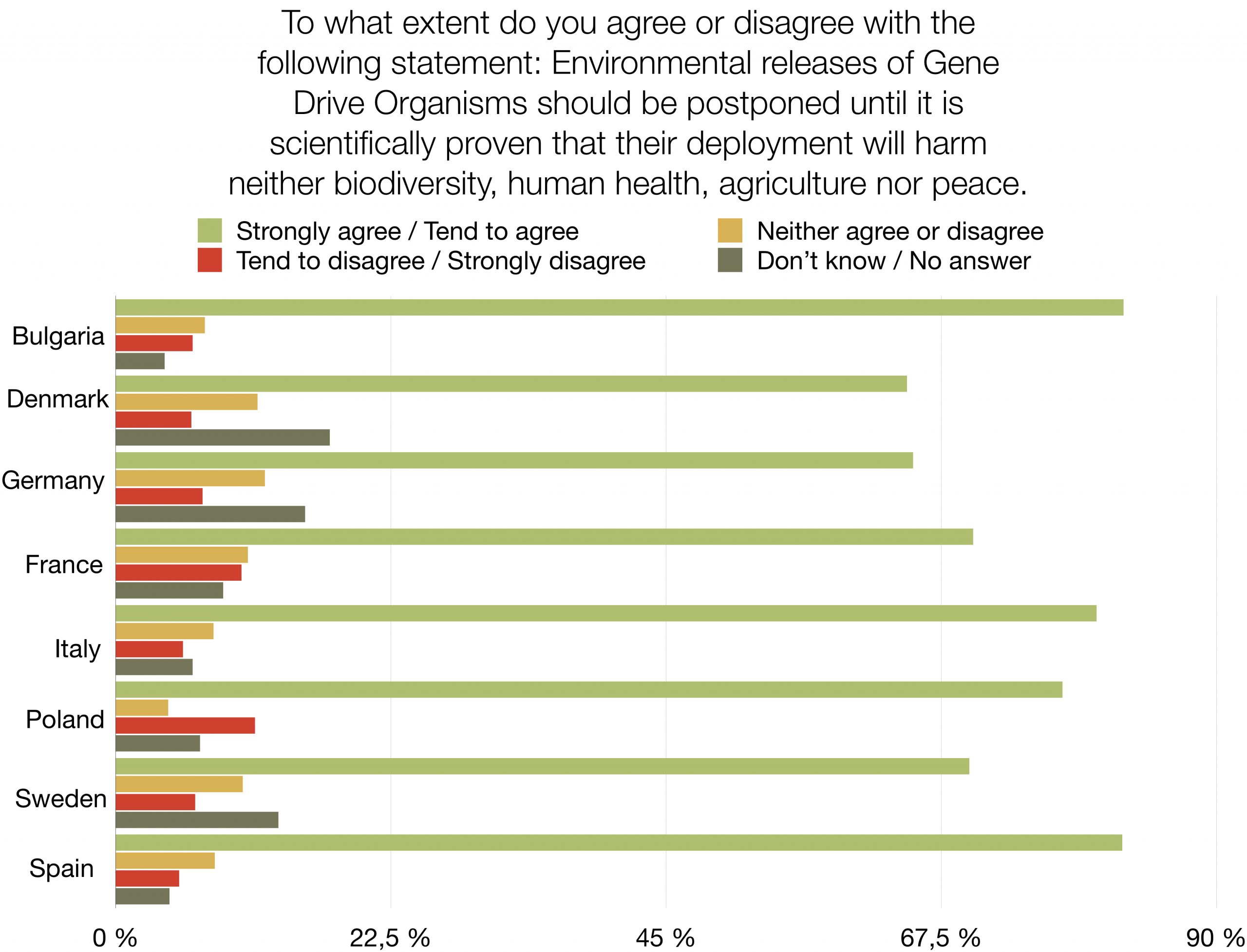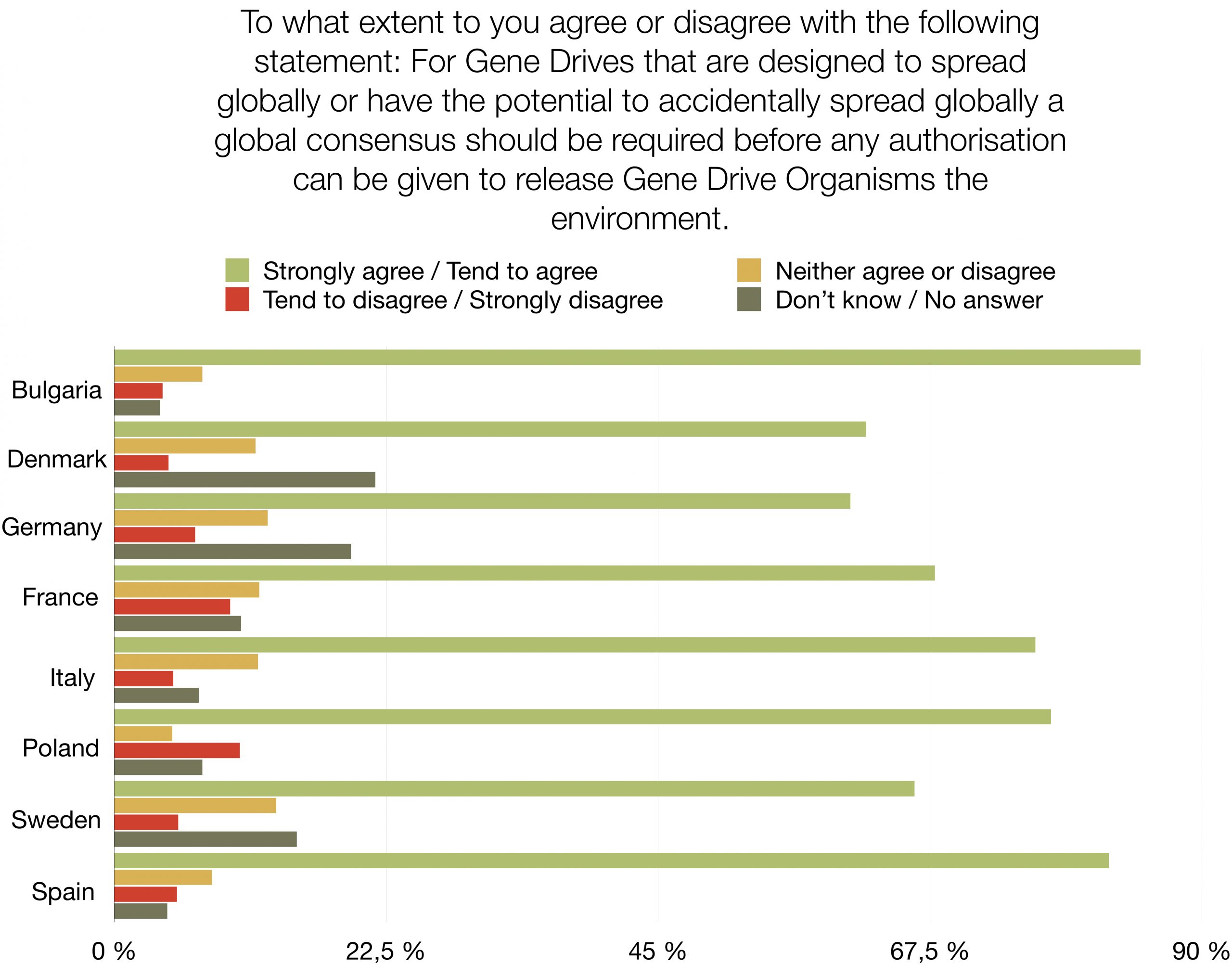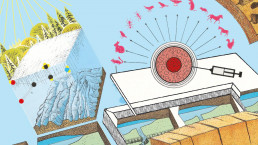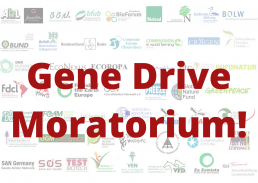News
European Parliament: no promotion of genetic technologies in development policy!
On Oct. 6, 2021, the European Parliament, in its plenary session, called on the EU Commission and EU member states, through its report on "The role of development policy in combating biodiversity loss in developing countries in the context of the implementation of the 2030 Agenda, "to actively protect the rights of future generations, not to promote genetic technologies with development aid funds and, in particular, not to allow the release of Gene Drive organisms.
Mareike Imken, coordinator of the European Stop Gene Drive campaign, welcomes this resolution:
"Here, for the third time in a row, the European Parliament reinforces its demand not to use Gene Drive technology for precautionary reasons. This demand is also important because the first field trials with the Gene Drive technology are to be implemented in the next few years in Burkina Faso by the Target Malaria project consortium." As noble as the goal thus pursued is to fight malaria - it is also important not to take lightly the unpredictable and potentially catastrophic consequences of cross-border, uncontrollable and irreversible genetic modification or eradication of mosquitoes. I urge the EU Commission and the EU Member States to implement the demands of the European Parliament nationally and internationally!" said Imken.
In paragraph 32, the European Parliament expands on its demand of June 8, 2021, from the EU Biodiversity Strategy and its resolution of January 16, 2020, on the 15th Conference of the Parties to the UN Convention on Biological Diversity:
"[The European Parliament] determines that gene drive technology, such as in genetically modified mosquitoes to control vector-borne diseases, constitutes serious and emerging threats to the environment and nature, including irreversible changes in food supply chains and ecosystems, and losses of biodiversity - a diversity on which the world's poorest depend for their livelihoods. Reiterates its concern about the new legal, environmental, biosafety, and governance challenges that could result from the release of organisms modified by Gene Drive into the environment, even if the release is for conservation purposes; Reaffirms that the free, prior and informed consent of indigenous peoples and local communities must be obtained before introducing technologies that may affect their traditional knowledge, innovation, habits and livelihoods, as well as land use and resource and water consumption; insists that in doing so, all populations potentially affected must be involved in advance in a participatory manner; Considers that gene drive technologies raise concerns about the difficulties of predicting the behavior of affected organisms and that gene drive modified organisms could themselves become invasive species, and therefore, in accordance with the precautionary principle, the release of gene drive modified organisms should not be permitted, even for the purpose of conservation of nature."
From Mareike Imken's point of view, it would be an important further step, also in view of the bad experiences with patented genetically modified seeds in Africa and Latin America, to implement the demand in paragraph 28 of the European Parliament in national development aid programs. In paragraph 28, the European Parliament urges the Commission and Member States to "take into account the Union's obligations under international conventions and also to ensure that no genetic modification technologies are promoted in developing countries with development aid funds."
This resolution is a non-binding opinion of the European Parliament with recommendations to the EU Commission and EU Member States for their international cooperation and work in international conventions such as UN CBD, UNEP, FAO and trade agreements. To implement these recommendations, the EU Commission would have to take them up in its own legislative proposal, which would then have to be confirmed by the European Parliament and EU Member States. However, these recommendations could also find their way into less formally agreed negotiating positions of the EU in its international work.
--------------------------
On the resolution:
- Resolution: European Parliament on the role of development policy in addressing biodiversity loss in developing countries in the context of the implementation of the 2030 Agenda (2020/2274(INI)) - Para. 32 on Gene Drives. (06.10.2021)
- Resolution: Previous European Parliament resolution on Gene Drives: Report on "EU Biodiversity Strategy for 2030: More space for nature in our lives (2020/2273(INI)) - Para 148 on Gene Drives.
- Resolution: European Parliament resolution on the 15th meeting of the Conference of the Parties (COP15) to the Convention on Biological Diversity (2019/2824(RSP)) - para. 15 on Gene Drives (16.01.2021)
IUCN: The discussion on gene drives
The discussion on gene drives in the World Conservation Union (IUCN)
In view of the possibility of using gene drives to remove introduced invasive species from sensitive ecosystems, the International Union for Conservation of Nature (IUCN), also known as the World Conservation Union, has been discussing how to deal with this technology since late 2015.
At its General Assembly in Hawaii in September 2016, the IUCN adopted a resolution¹ that, among other things, mandated IUCN to prepare a scientific report on the implications of synthetic biology and gene drives for biodiversity conservation. Based on this scientific report, IUCN originally intended to take a position on the role of gene drive technology for nature conservation at its subsequent General Assembly in 2020.
In part through public protest and at the urgin of global conservation luminaries², among others, IUCN committed in its 2016 resolution to refrain from any support or endorsement of research, field trials or use of gene drive technology until the report would be available.
The report, entitled Genetic frontiers for conservation³, was published in May 2019 and met with harsh criticism from IUCN member organisations as well as conservation and development organisations from around the world.
An analysis⁴ conducted by the research and advocacy NGO ETC Group concluded that a majority of the report’s authors were known proponents of genetic engineering and should not have been engaged by IUCN, in part because of their economic self-interest in the development of the technologies studied. In a subsequent open letter signed by 231 civil society organisations and several scientists, the report was criticised as “regrettably one-sided”, “biased” and “inappropriate for the intended policy discussion”. This report is not in line with the precautionary considerations of the Hawaii resolution. The signing organisations therefore called on IUCN to commission another scientific report based on a precautionary analysis of the risks of the technology and to wait until such a counter-report is available before taking a decision on the issue.⁵
In a similar vein was the request of a letter from 23 IUCN members to the IUCN Council in October 2019. According to its signatories, more time is needed for a fundamental, comprehensive, balanced discussion based on the precautionary principle, with greater involvement of IUCN Members, before any IUCN decision is taken.⁶
Faced with this criticism, the IUCN Council withdrew its plan to adopt a position at its membership process originally planned for June 2020. Instead, principles⁷ for the discussion around the topic were defined in a consultation open to members. These are to be voted on at the IUCN World Conservation Congress in 2021 and will serve as the basis for disscussions until position will be voted on at the following Members’ Assembly.
[1] IUCN Library System Website (2016). IUCN, International Union for Conservation of Nature Resolution; c2020. WCC-2016-Res-086 – Development of IUCN policy on biodiversity conservation and synthetic biology. World Conservation Congress; 2016; Hawaii. Online: https://portals.iucn.org/library/sites/library/files/resrecfiles/WCC_2016_RES_086_EN.pdf
[letzter Zugriff: 07.12.2020]
[2] SynBioWatch Website (2016). A Call for Conservation with a Conscience. No Place for Gene Drives in Conservation. Online:
https://www.synbiowatch.org/wp-content/uploads/2016/09/letter_vs_genedrives.pdf [letzter Zugriff: 07.12.2020]
[3] Redford KH, Brooks TM, Macfarlane NBW, Adams JS (2019). Genetic frontiers for conservation: an assessment of synthetic
biology and biodiversity conservation: technical assessment. IUCN Publication. Online: https://portals.iucn.org/library/node/48408
[letzter Zugriff: 07.12.2020]
[4] ETC Group Website (2019). ETC Group. Driving Under The Influence? A review of the evidence for bias and conflict of interest in the IUCN report on synthetic biology and gene drive organisms. Online: https://www.etcgroup.org/sites/www.etcgroup.org/files/files/etc-iucn-driving_under_influence.pdf [letzter Zugriff: 07.12.2020]
[5] GeneWatch UK Website (2019). GeneWatch UK. Open letter to the IUCN regarding the report Genetic Frontiers for Conservation. Online: https://www.genewatch.org/uploads/f03c6d66a9b354535738483c1c3d49e4/IUCN_let_16July2019.pdf
[letzter Zugriff: 07.12.2020]
[6] Institute for Nature Conservation in Albania Website (2019). Instituti për Ruajtjen e Natyrës në Shqipëri. Open Letter by the undersigned IUCN Members to the IUCN Council. Online: https://inca-al.org/sq/postimet/njoftime/open-letter-by-the-undersigned-iucn-members-to-the-iucn-council [letzter Zugriff: 23.03.2021]
[7] IUCN Congress 2020 Website (2020). IUCN; c2020. 075 – IUCN Principles on Synthetic Biology and Biodiversity Conservation. Online: https://www.iucncongress2020.org/motion/075 [letzter Zugriff: 07.12.2020]
European Parliament calls for ban on gene drive technology
Report on the EU' Biodiversity Strategy for 2030: Precaution prevails
9.06.2021, Berlin -The European Parliament yesterday confirmed it‘s precautionary stance towards the use of a new genetic engineering technology called gene drive.[i] In it´s report on the EU’s Biodiversity Strategy for 2030, adopted at the European Parliament’s plenary on 08.06.2021, Parliamentarians demand that „no releases of genetically engineered gene drive organisms should be allowed, including for nature conservation purposes, in line with the precautionary principle.“
Mareike Imken, coordinator of the European Stop Gene Drive Campaign welcomes this decision and comments:„With its position today, the European Parliament recognizes that this technology raises a series of scientific, regulatory, societal and ethical questions and concerns. As its use could severely harm biodiversity, the European Parliament calls to postpone any environmental releases until these questions have been addressed and settled. This is an important message that should feed into the ongoing discussions about global regulations at the next meeting of the International Union for Conservation of Nature (IUCN) in September in Marseille and those of the Convention on Biological Diversity in October in Kunming, China.“
27civil society and science organizations from across the EU had sent a letter to Parliamentarians in support of the amendment ahead of the vote. It „provides reasonable suggestions on how to implement the European Parliament’s previous position in its resolution on the 15th meeting of the Conference of Parties (COP15) to the Convention on Biological Diversity (2019/2824(RSP)“.
In that previous position, adopted in January 2020, the European Parliament had called “on the Commission and the Member States to call for a global moratorium at the COP15 on releases of gene drive organisms into nature, including field trials, in order to prevent these new technologies from being released prematurely and to uphold the precautionary principle, which is enshrined in the Treaty on the Functioning of the European Union as well as the CBD“.
Background information:
Text adopted in the report on the EU Biodiversity Strategy for 2030: Bringing nature back into our lives (2020/2273(INI)):[ii]
The European Parliament,
148. “Is concerned about the new legal, environmental, biosafety and governance challenges that might arise from the release of genetically engineered gene drive organisms into the environment, including for nature conservation purposes; acknowledges the outcome of the Ad Hoc Technical Expert Group of the Convention on Biological Diversity on gene drives and living modified fish, which raises concerns about the difficulties of predicting their behavior, assessing their risks and controlling them after release; notes that gene drive organisms could become invasive species in themselves; considers that global and EU-level risk assessment guidance materials, tools and an environmental monitoring framework, as well as clear global governance and effective mechanisms for controlling and reversing the effects of gene drive organisms, should be fully developed, and that additional research is required on the health, environmental, ecological, ethical and other implications of gene drive organisms to better understand their potential impact; considers therefore that no releases of genetically engineered gene drive organisms should be allowed, including for nature conservation purposes, in line with the precautionary principle ; “.
---------------
Download the press release here.
Letter to MEPs by civil society organisations prior to the vote.
[i] Voting results and margins for EU Biodiversity Strategy
[ii] Report on the EU Biodiversity Strategy for 2030: Bringing nature back into our lives
World Malaria Day: Do we need gene drives to fight malaria?
Gene drive technology carries high risks. Yet it is being promoted by the Bill & Melinda Gates Foundation as a solution to malaria. On the occasion of World Malaria Day, the Stop Gene Drives campaign is launching a project that presents different perspectives on the issue of malaria control and highlights alternative, possibly less risky approaches and innovations to combat malaria.
Infectious diseases such as malaria, dengue fever and Lyme disease are transmitted to humans by so-called vectors, such as mosquitoes or ticks. In the case of malaria, the pathogen and thus the disease is spread exclusively by Anopheles mosquitoes. A global program of malaria control has so far helped to roll back the disease in many regions of the world. Already 38 countries have been certified malaria-free, but there remain 86 countries where malaria control has not been adequately implemented, resulting in several hundred thousand deaths.
This is where the discussion of Gene Drive technology comes into play. Mosquitoes are genetically modified in the laboratory using a process known as CRISPR/Cas so that they pass on a new trait to all their offspring, even if that trait causes the population or the entire species to become extinct. Gene drive mosquitoes produced in this way are expected to massively reduce the number of Anopheles mosquitoes in Africa and thus prevent the transmission of malaria. Gene drives are therefore being promoted as an effective technological solution to combat malaria.
Mareike Imken, coordinator of the Stop Gene Drive campaign, explains in a short interview what concerns there are about the use of gene drive technology and what the goal of the European Stop Gene Drive campaign is. (To the interview)
A leading role in the development of such gene drives is played by the international research consortium Target Malaria, which is largely funded by the Bill & Melinda Gates Foundation. In an interview with us, Dr. Andreas Wulf of Medico International explains their influence on global health policy and the selection of priorities and measures, including those to combat malaria, that are influenced by them. (To the interview)
Target Malaria's plans to use gene drives have already reached the stage where the first projects have been launched in Africa, including Burkina Faso. In July 2019, Target Malaria conducted its first field tests in Burkina Faso using genetically modified sterile mosquitoes that did not yet carry Gene Drive. These trials were considered a precursor to the release of Gene Drive mosquitoes in a later phase of the project. These and subsequent tests have met with resistance from parts of the population in Burkina Faso, as Ali Tapsoba, human rights activist, explains in his interview with us. (To the interview) He is the spokesperson for civil society resistance to the release of Gene Drives in Burkina Faso. Treatment and profilaxis with Artemisia teas grown in Africa are among the measures he would prefer over the use of Gene Drive technology. However, the World Health Organization (WHO) warns against this. Internationally renowned professor Pamela Weathers of Worcester Polytechnic Institute explains how effective and safe Artemisia tea infusions are for treating or preventing malaria in her interview with us. (To the interview)
Burkina Faso has, according to epidemiologist Dr. Sory, a strong strategy to combat malaria. A cocktail of different measures is needed to fight this disease and decrease other diseases at the same time. Better drainage systems, awareness raising and access to health care are just a few points raised in the interview. (To the interview)
Artemisinin is a component derived from the Artemisia plant and present in most anti-malarial drugs nowadays. Lucile Cornet-Vernet and Arnaud Nouvion from the Maison de l'Artemisia, talk about the potential to use the plant as tea as a preventive and curative method for malaria. Furthermore, they make clear that final clinical studies are needed to get the plant approved by the WHO. (To the interview with Lucile and Arnaud)
162 organizations call for global gene drive moratorium
A broad coalition of 162 organizations has sent an open letter to Frans Timmermans, Vice President of the European Commission. It demands that plants and animals modified using new genetic engineering methods continue to be strictly regulated in the future. Furthermore, the EU Commission should support a global moratorium on gene drive organisms.
The existing EU genetic engineering standards ensure the implementation of the precautionary principle and protect the environment and consumers, wrote the organizations from the fields of environmental and consumer protection, agriculture and the food industry. Farmers and consumers would be free to choose whether to eat or grow genetically modified crops. The current occasion for the open letter is a study on the current status and future regulation of genetically modified organisms in the European Union (EU). The governments of the European member states had asked the EU Commission in November 2019 to prepare such a study. It should take into account various aspects, including scientific progress, the legal situation, as well as a publication of the "European Group on Ethics in Science and New Technologies." The European Commission has announced that they will publish the study at the end of April.
The authors of the letter to Timmermans and other members of the EU Commission also call on the Commission to ensure that the regulation of genetic engineering in the UK remains EU-compliant after Brexit. This is because the British government is currently planning to revise its genetic engineering legislation. As reported by Infodienst, it invited stakeholders to a consultation process at the beginning of the year, which ended in mid-March. The organizations are now calling on Timmermans to lobby the UK government to drop these plans. If genetically modified plants were to be less strictly regulated in the UK in the future, this would also affect the trade with the EU.
Finally, the 162 organizations call for the EU Commission to support a worldwide moratorium on the use of so-called gene drive organisms. Gene drive organisms result from a special application of new genetic engineering. This poses the risk that entire species of organisms could be severely decimated or wiped out. The European Parliament had already spoken out in favor of a global moratorium in January 2020 in the form of a petition. Especially in times of "ecological crisis, when a million species are threatened," experiments with a technology that is also referred to as "extinction on demand" cannot be carried out, according to the justification.
- Press release on letter by IFOAM and others to EU Com Vice-President Timmermans: Don’t deregulate GM crops & animals. (30.03.2021)
- Letter by IFOAM EU and others to EU COM Vice President Timmermans: Don't deregulate GM crops & animals (30.03.2021)
- Answer by European Commission to the letter by IFOAM EU and others (06.05.2021)Lett
Survey: EU citizens reject genetic engineering of wild species with Gene Drives
Should humanity release genetically engineered gene drive organisms into nature? The response of a majority of citizens in eight European countries is: “No, the risks are too high”. This first opinion poll on the subject shows high levels of rejection (46% - 70%) and very low levels of support (7% - 16%) for the use of Gene Drive technology in the environment. The survey amongst nearly 9.000 people is representative of 280 million EU citizens. It was commissioned by nine NGOs demanding an informed and inclusive public debate and a global moratorium on the environmental release of this new type of genetically modified organisms. The survey also reveals that a large proportion of respondents is still undecided (14% - 27%) or did not know how to answer (1% - 24%).
"Such a powerful technology with potentially irreversible consequences for wild species and all their ecosystems must be controlled by strict international rules and procedures of decision making. We do not believe that the release of gene drive organisms from the lab into the environment should happen at all. At least, it would require strict international standards of risk and technology assessment and a prior inclusive, democratic decision making based on precaution and the prior informed consent of all peoples and states potentially affected" states Mareike Imken from Save Our Seeds, Germany, who coordinates the European Stop Gene Drive campaign."
A large majority of respondents (65%-82%) agree that environmental releases of gene drive organisms should be postponed until there is scientific proof that their release would not harm biodiversity, human health, agriculture or peace. A similar majority (61% - 85%) agrees that the authorisation of environmental releases of gene drive organisms that could spread globally should require a global consensus.
This representative survey was conducted by the international market research institute YouGov and polled 8.826 citizens, from 8 EU countries, including Germany, Italy, France, Spain, Poland, Denmark, Sweden and Bulgaria in December 2020. It was commissioned by WeMove Europe, Save Our Seeds (Germany), Skiftet (Sweden), France Nature Environnement (FNE) (France), POLLINIS (France), OGM Dangers (France), Bund für Umwelt und Naturschutz (BUND) (Germany), Deutscher Naturschutzring (DNR) (Germany), Umweltinstitut München (Germany), Za Zemiata (Bulgaria).
Downloads
Download YouGov Results Gene-Drive Opinion Poll | PDF
Download Gene Drive Acceptance Survey - A graphic overview of the results | PDF
Further information
EU-wide petition for global gene drive moratorium
Open letter by over 200 organizations worldwide calling for global gene drive moratorium
Resolution of the European Parliament for a global gene drive moratorium
Online-Discussion: Gene Drives - Protecting People and Nature through Genetic Extermination?
Ricarda Steinbrecher, geneticist and board member of the European Network for Scientists for Social and Environmental Responsibility (ENSSER), emphasized that it is difficult or even impossible to make reliable predictions about the effects of a future application of Gene Drives, especially at the current time. After all, organisms are released which then independently carry out the genetic modifications in each generation. "Mistakes can be made every time. Every time, something else can be added." To ensure the preservation of biodiversity, new technologies such as Gene Drives must be looked at very closely to ensure that they do not pose any risks to our ecosystems. This is why she strongly advocated the precautionary principle during the international negotiations on the regulation of gene drive technology at the UN Convention on Biological Diversity. As a long-standing scientific advisor and participant in expert groups within the UN Convention on Biological Diversity, she reported that there is a strong influence of lobby groups on these expert bodies: For example, the Bill & Melinda Gates Foundation, one of the main financiers of the technology, had invested 1.6 million dollars in a PR agency to increase the acceptance of Gene Drives. She concluded: "The pressure to implement this technology is not commensurate with the risk."
Ali Tapsoba de Goamma, human rights and environmental activist from Burkina Faso and spokesperson for a civil society association of 40 organizations for agroecology and against Gene Drives (CCAE), reported that since 2012, the project Target Malaria has been preparing to decimate malaria-transmitting mosquitoes in Burkina Faso by means of Gene Drives. In 2019, the first field tests with genetically modified male mosquitoes that are not capable of reproducing took place, but not any Gene Drive Organisms have been released yet. Ali Tapsoba de Goamma criticized that Target Malaria had obtained the consent of the government and village leaders for these tests, but not the consent of the entire population of Burkina Faso. Rather, they had taken advantage of the fact that there are so many illiterate people in the local villages. The majority of the inhabitants of Burkina Faso are against these experiments. He raised the question: "Why not try this first in scientifically better equipped countries, but in Burkina Faso?" In his view, Burkina Faso was in a position to combat malaria itself. He said that this does not require gene drives, but a good health concept.
Dr. Andreas Wulf, doctor and consultant for global health at the medical emergency aid organization Medico International, emphasized that epidemics like malaria require long-term strategies. The idea of trying to solve such a disease with the one-time use of a technology without continued commitment is questionable, he said. One should not rely on such a "technological fix". Experience in combating other epidemics has shown that the success of the measures depends on good cooperation with the people on the ground and finding local solutions. He also criticized from a democratic point of view: "It is a problem that so much decision-making power is given to these private actors, the companies / foundations. A handful of people choose which area of research to invest in. In addition, the media coverage of research is also financially supported by these foundations". Dr. Andreas Wulf concluded that these private funds need to be embedded in the public health systems.
Mareike Imken, head of the Stop Gene Drive campaign of Save Our Seeds, explained that with the European campaign, which is supported by many organizations throughout Europe, she wanted to initiate a critical discussion in society and politics about "whether and if so, under what circumstances we want to use this technology and what restrictions it needs."
She went on to explain: "Gene Drives provides us as humanity with a tool to specifically eradicate or change wild species. In times of a species extinction that is existential for mankind, this must be considered and ethically discussed. This should not be decided lightly by those few people". She also points out that "the knowledge about Gene Drives is not yet sufficiently advanced".
In order to have time for this discussion, in-depth risk research including technology assessment and the development of internationally valid rules and decision-making mechanisms, a global moratorium on the release of gene drive organisms is needed. This moratorium must be adopted at the next Conference of the Parties of the UN Convention on Biological Diversity (COP 15).
78 organizations call on the European Commission to enact a temporary ban on the novel Gene Drive technology
Gene Drive technology: Species extinction through genetic engineering?
In an open letter initiated by Greenpeace EU, Friends of the Earth Europe, IFOAM EU and the German initiative Save Our Seeds, 78 environmental, agricultural, animal welfare and development aid organizsations from all over Europe are calling on the EU Commission to outlaw the release of so-called Gene Drive Organisms in the EU and internationally. With this new application of genetic engineering, entire animal populations and species in nature could be reprogrammed or eradicated.
Enabled by the genetic engineering method CRISPR/CAS9, mosquitoes, mice, fruit flies and other organisms can be manipulated in the laboratory to pass on a certain trait and the mechanism for genetic manipulation to all offspring and across generations. In this way, Gene Drive Organisms can replace their relatives in nature. The Gene Drive trait also asserts itself when it is deadly to the survival of the species – thereby ovveriding the normal rules of evolutionary selection.
The signatory organisations are calling on the EU to advocate a global moratorium on the release of Gene Drive Organisms at the next Conference of the Parties (COP 15) to the UN Convention on Biological Diversity (CBD). The European Parliament had already called for such a moratoirum in a resolution from January this year, responding to a call from over 200 signatories from Europe and worldwide.
"The loss of biodiversity is one of the greatest challenges of our time. While the risks of Gene Drive technology have not yet been scientifically assessed, it could have a massive impact on already damaged ecosystems. It is irresponsible to expose species and ecosystems to further risks“ explains the initiator of the European "Stop Gene Drives" campaign, Mareike Imken from the German initiative Save Our Seeds.
She adds: „The EU Commission recently presented its biodiversity strategy, with which it wants to make the EU a global pioneer for the protection of biodiversity and put an end to the ongoing mass extinction of species. The Gene Drive technology however is designed to drive wild populations and species into self destruction. The use of such a technology contradicts the aim of biodiversity conservation and the precautionary principle, which is the basis for international and EU nature conservation law. A global moratorium would give us the time to assess environmental and health risks, publicly evaluate and discuss this technology and to establish missing regulations and global decision-making mechanisms. In the meanwhile, noone in the world should use this technology."
The open letter signed by 78 organizations can be found here.
Further reading:
Further information on gene drives:
www.stop-genedrives.eu/en
29 German Organizations call for a Global Gene Drive Moratorium
In a joint open letter sent to the German federal ministers Karliczek, Klöckner and Schulze on February 19, 2020, an alliance of 29 German organizations called on the German government to support a global gene drive moratorium in the upcoming international negotiations.
The reason for the joint letter were important EU and international decisions with regard to the gene drive technology:
At the Conference of the Parties to the UN Convention on Biological Diversity planned for October 2020 in China, the German federal government could play an important role within the scope of its EU Council Presidency. Furthermore, the German government would be able to already set the course for the regulation of this technology at the expert conferences taking place in advance of the convention, especially at SBSTTA 24 planned for June 2020 [postponed to May 2021 due to COVID].
In addition, as part of Germanys membership in World Conservation Union (IUCN), the German government could input to a consultation process on draft resolution 075 on the role of synthetic biology (including gene drives) for the protection of biodiversity within the IUCN, ahead of World Congress planned for May 2020 [postponed to September 2021). This resolution is meant to provide the basis for an inclusive discussion process within IUCN. Its members are invited to exchange views on the potential role of applications of synthetic biology, including gene drives, for the conservation of biodiversity. At the IUCN World Congress 2024, the world conservation organization will vote on its official position on this issue.
In its letter, the alliance calls on the German federal government to follow the European Parliament's vote of January 16, 2020, at the CBD COP 15, in which the European Parliament petitioned the EU to motion for a resolution calling for a global moratorium on the release of gene drive organisms into nature at the next Conference of the Parties to the UN Convention on Biological Diversity in order to prevent premature experiments with the technology in nature.
19. February 2020
European Parliament calls for a Global Gene Drive Moratorium
At its plenary session on January 16, 2020, the European Parliament defined its position for the 15th Conference of the Parties to the UN Biodiversity Convention (COP 15 CBD). In their resolution, MEPs call on the EU to support a global moratorium on gene drives in the international negotiations of the CBD. In a joint letter, an EU-wide alliance of more than 50 NGOs, including Greenpeace, Friends of the Earth Europe and IFOAM EU, had previously called on MEPs to vote for such amendments.
The next Conference of the Parties (COP 15) to the CBD in China could be one of the last moments to stop planned releases of gene drive mosquitoes by the Target Malaria project. A release of gene drive organisms would cause an uncontrollable spread of the genetically modified organisms in an unprecedented manner - and result in a global spread and irreversible change or damage to ecosystems. Once released, there is currently no way to remove gene drive organisms from the wild or to reverse changes and damage to ecosystems, food webs and biodiversity. Hence, such a release is contrary to the precautionary principle. This principle was created by the CBD specifically to protect biodiversity and forms the basis of both European and German nature conservation law.
- Resolution of the European parliament (see paragraph 13)
- Civil Society Letter to the Members of the European Parliament
- Gene Drive Briefing für EU-Parlamentarier*innen auf Englisch
- Summary of the scientific Gene Drive Report by ENSSER, VDW und CSS

